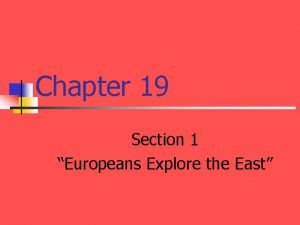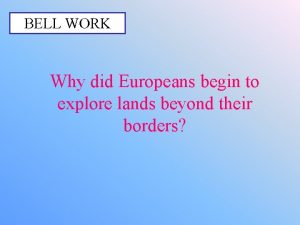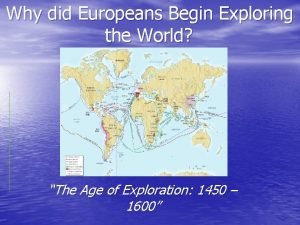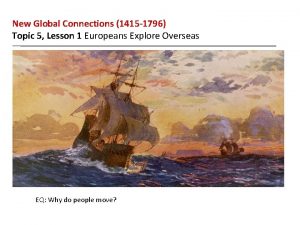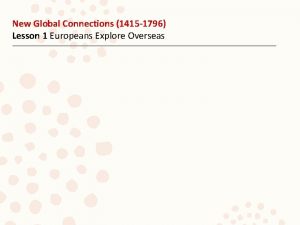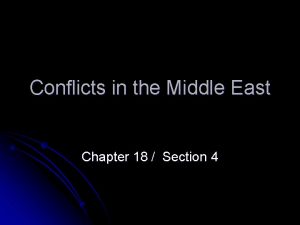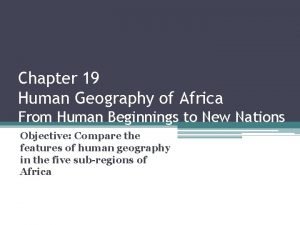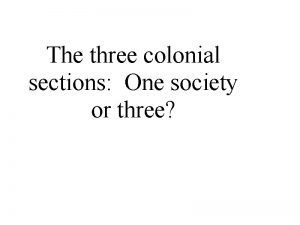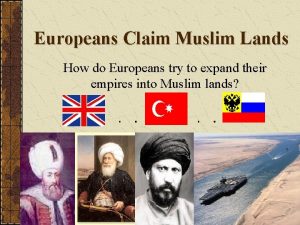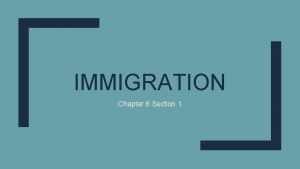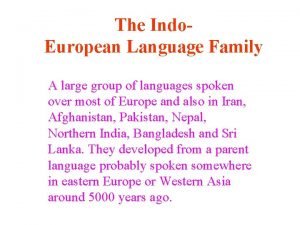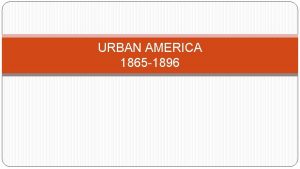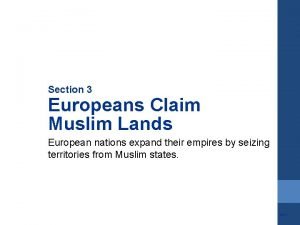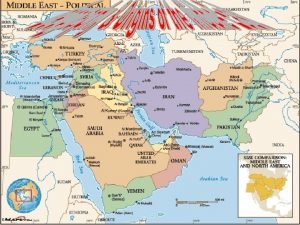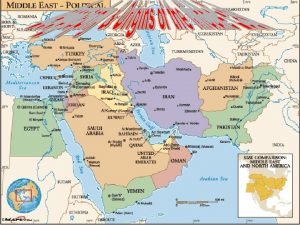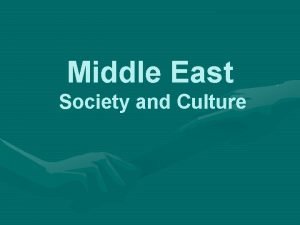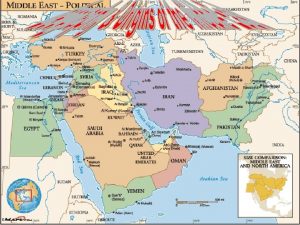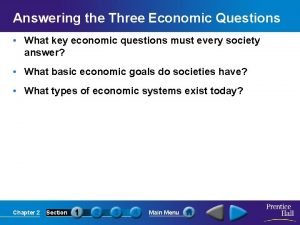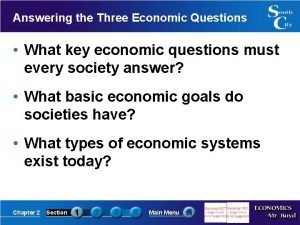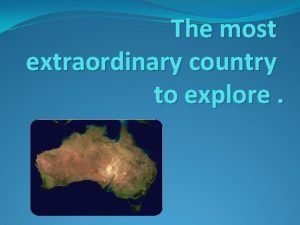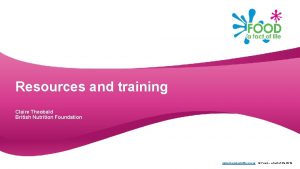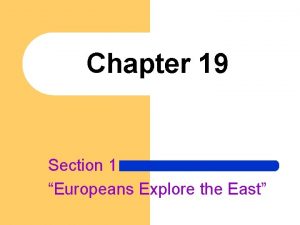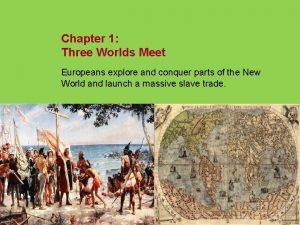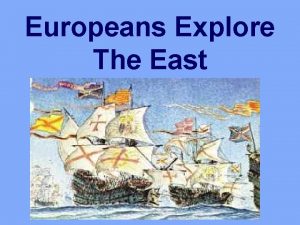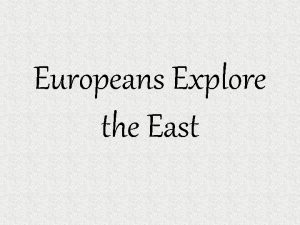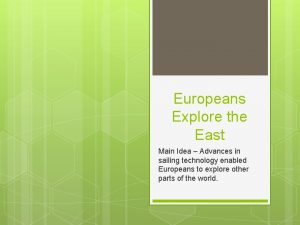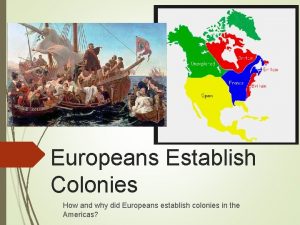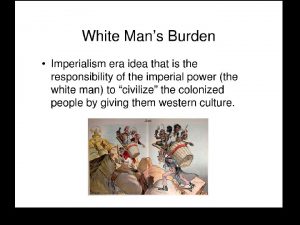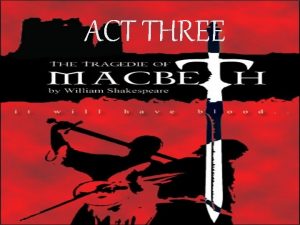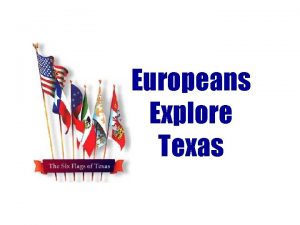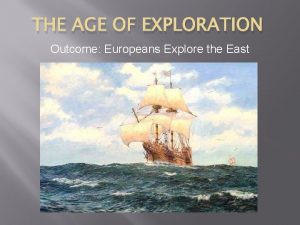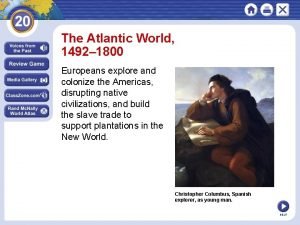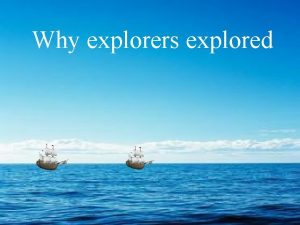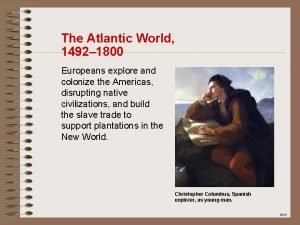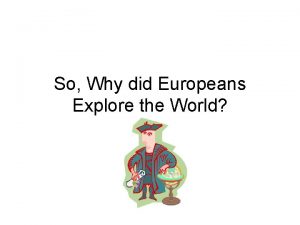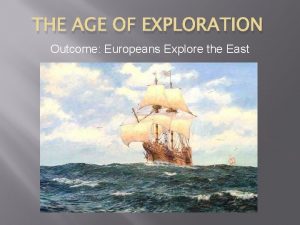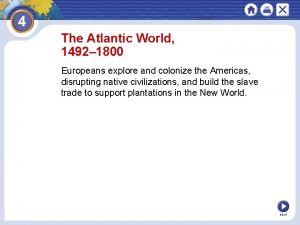Chapter Three Section One Europeans Explore the East




























![Christofo Colon [1451 -1506] Christofo Colon [1451 -1506]](https://slidetodoc.com/presentation_image_h2/69eb3328c796507ef4e084d797f45073/image-29.jpg)



























































- Slides: 88


Chapter Three – Section One Europeans Explore the East

Chapters in Brief - Overview “God, glory, and gold” drove Europeans’ early exploration of Asia. They took control of Asian trade, with Portugal leading the way. Eventually, nations of northern Europe displaced the Portuguese.

Exploration – Chapter Three Objective Explain what led to European Exploration

Chapters in Brief For many centuries, Europeans had been largely, though not completely, isolated from contact with people from other lands. That changed in the 1400 s. One reason for this change was that Europeans hoped to gain new sources of wealth. By exploring the seas far from Europe, traders hoped to find new, faster routes to Asia-the source of spices and luxury goods. Their goal was to win access to these lands and bypass the Muslims and Italians who currently controlled this trade. Another reason was the desire to spread Christianity to ne lands. The Crusades had ended, but bad feelings between Christians and Muslims remained. The Christians of Europe wanted to convert the people of Asia.

Chapters in Brief Advances in technology made these voyages possible. A new kind of ship, the caravel, was stronger built than earlier ships. It had triangle-shaped sails that allowed it to sail against the wind. Ships could now travel far out into the ocean. The magnetic compass allowed sea captains to better stay on course. The first nation to develop and use these new technologies was Portugal. Prince Henry of Portugal was deeply committed to the idea of exploring beyond the seas. In 1419, he started a school of navigation where sea captains, mapmakers, and navigators could meet, learn, and exchange ideas. Over the next few decades, Portuguese captains sailed farther and farther down the west coast of Africa. In 1488, Bartolomeu Dias led the first voyage to reach the southern tip of Africa. Ten years later Vasco da Gama led a ship 27, 000 miles around Africa, to India, and back. The Portuguese had found a sea route to Asia.

Chapters in Brief The Spanish, meanwhile, had plans of their own. Italian sailor Christopher Columbus convinced the king and queen that he could reach Asia by sailing west. In 1492, instead of landing in Asia, Columbus touched land in the islands of the Americas, land unknown to Europeans. At first, though, people still thought that he had landed in Asia. Spain and Portugal argued over which nation had the rights to the land that Columbus had claimed. In 1494, they signed the Treaty of Tordesillas. It divided the world into two areas. Portugal won the right to control the eastern parts and Spain the western parts – including most of the Americas. Portugal moved quickly to make the new Indian Ocean route pay off. In 1509, it defeated a Muslim fleet off the coast of India and thus became the master of Indian trade. Soon, it captured cities in Indian and on the Malay peninsula. Portugal now had power over islands that were so rich in desirable spices that they were called the Spice Islands. Spices now cost Europeans one-fifth of what they had cost before, while still making Portugal very wealthy.

Chapters in Brief Other European nations joined in this trade. In the 1600 s, the English and Dutch entered the East Indies to challenge Portugal. The Dutch fleet – about 20, 000 ships – was the largest in the world. These two nations quickly broke Portuguese power in the area. Then both nations set up an East India Company to control Asian trade. These companies were more than businesses. They were like governments, with the power to make money, sign treaties, and raise their own armies. The Dutch managed to drive out the English and grab the Asian trade for themselves. The Dutch made their trading headquarters on the island of Java in the East Indies. By 1700, the Dutch ruled much of Indonesia. They had trading posts in many other Asian countries and commanded the southern tip of Africa. At the same time, both England France finally gained footholds in India. While the Europeans controlled the trade between Asia and Europe, they had little impact on most people living in these areas. From 1500 to 1800, the people of Asia were largely untouched by the European traders.

When did exploration happen? Ø it took place during the 1400’s-1600’s Ø It was around the same time as the Renaissance in Europe and the Reformation

Age of Exploration Reasons 1. Desire to grow rich 2. Desire to spread Christianity 3. Advances in sailing technology Ø Exploration is a search for new land Ø Exploration is motivated by God, Gold, and Glory

Why Explore? Ø wanted God, the Gold and the Glory Ø Europe depended on spices from Asiasafest route would be by sea Ø profitable trade with Asia Ø Renaissance thinkers expanded people’s ideas on exploring

What Countries were Involved? Ø Portugal Ø Spain Ø France Ø England Ø Netherlands

Impact on the New World and the Old World (Europe) New World: Ø cultural diffusion - new ideas brought to the new world Ø disease Ø slavery Ø slave trade = triangular trade Ø economies based on agricultural products Old World (Europe): Ø Ø disease more $$$ power hungry more trade – economy expanding … agricultural

A Map of the Known World, pre- 1492

Prince Henry, the Navigator Ø Portuguese Ø financed exploration Ø School for Navigation, 1419

Museum of Navigation in Lisbon

Bartolomeu Dias Ø 1488 - Portuguese navigator and explorer who led the first European expedition to sail to the Cape of Good Hope (Africa) and back to Portugal Ø opened the sea route to Asia via the Atlantic and Indian Oceans

Vasco da Gama Ø Da Gama used the information learned from Dias and set out on his own exploration Ø proved that ships could reach East Asia by sailing around Africa to Calcutta, India Ø Da Gama establishes a direct trade route to Asia

Exploration – Chapter Three Objective Explain what led to European Exploration

Age of Exploration Essential Question What were the motives behind European exploration in the 1400 s? Explain. Write three complete sentences in the summary location on your note sheet



Chapters in Brief - Overview Starting in 1492, the Spanish built a large empire in the Americas, but the native people suffered. In North America, the Dutch, French, and English fought for control. England finally won. The labor of enslaved persons brought from Africa supported the American colonies. The contact between the Old World and the New produced an exchange of ideas.

Exploration – Chapter Four Objective Analyze the impact of European exploration and colonization of the Americas

Chapter Four – Section One Spain Builds an American Empire

Chapters in Brief In 1492, Christopher Columbus, an Italian sailor, led a voyage on behalf of Spain. He sailed west a from Europe intending to reach Asia but instead landed in the Americas. This was land that Europeans had not known existed before. Columbus thought at first that he had reached Asia, or the Indies. He misnamed the natives he met Indians and claimed the land for Spain. The king and queen agreed to let him lead another voyage. This one was an expedition to form colonies, or controlled lands, that Spain would rule. In 1500, a Portuguese explorer landed in Brazil and claimed that land for his country. In 1501, another Italian sailor on behalf of Spain, Amerigo Vespucci, explored the eastern coast of South America. He said that these lands were not Asia but a new world. Soon after, a mapmaker showed the lands as a separate continent. He named them America after Vespucci.

Chapters in Brief Other voyages gave Europeans more knowledge about the world. One explorer reached the west coast of Central America and firs saw the Pacific Ocean. Another, Ferdinand Magellan, led a bold expedition from Spain that sailed completely around the world. Magellan himself died about halfway around. However, a few members of his crew survived. They returned to Spain after sailing for almost three years. Spanish conquistadors, or conquerors, also began to explore the lands of the Americas. There they found great riches. In 1519, Hernando Cortes came to Mexico and defeated the powerful Aztec Empire. The Spanish had the advantage of rifles and cannons. They also had the aid of several native groups who were angry over harsh Aztec rule. In addition, the Aztec were seriously weakened by new diseases brought to the Americas with the Spanish. Native peoples had no resistance to measles, mumps, and smallpox, which killed them by the hundreds of thousands.

Chapters in Brief About 15 years later, another Spanish force, led by Francisco Pizarro, conquered the mighty Inca Empire of South America. Once again, the Spanish gained access to huge amounts of gold and silver. By the ide-1500 s, Spain had formed an American empire that stretched from modern-day Mexico to Peru. After 1540, the Spanish looked north of Mexico and explored the future United States. However, one large area of the Americas – Brazil – remained outside the control of Spain. Brazil was the possession Portugal. Colonists there built huge farms called plantations to grow sugar, which was in demand in Europe. The Spanish had a pattern of living among the people they conquered. Because few Spanish settlers in the Americas were women, Spanish men had children with native women. These children and their descendants formed a large mestizo population, people with mixed Spanish and Native American blood. The Spanish also formed large farms and mines that used natives as slave labor. Many landowners treated the native workers harshly. Some Spanish priests criticized this treatment. In 1542, the Spanish stopped making slaves of native peoples. They soon, however, would bring enslaved Africans to the Americas to meet labor demands.
![Christofo Colon 1451 1506 Christofo Colon [1451 -1506]](https://slidetodoc.com/presentation_image_h2/69eb3328c796507ef4e084d797f45073/image-29.jpg)
Christofo Colon [1451 -1506]

Voyages of Columbus Ø competition for wealth in Europe Ø Christopher Columbus - 1492 sets sail Ø attempts to sail west to reach Asia instead of south and then east around Africa Ø Columbus first lands in the Americas on an island in the Caribbean Sea Ø mistakenly believed he had found a new water route to Asia by sailing west Three ships: 1. the Nina 2. the Pinta 3. the Santa Maria

The Pinta The Nina The Santa Maria

Voyages of Columbus “Tierra, Tierra” (land, land) Ø October 12, 1492 the Pinta sees land Ø he thought he reached the East Indies, instead he reached the Bahamas Ø he greeted the indigenous as los indios (Indian) Ø he named the island Salvador or “holy savior”

A rocky shore of the Dutch West Indies. Probably similar to Columbus’s first sight of land.

Voyages of Columbus Ø Amerigo Vespucci is the man honored for suggesting that Columbus had discovered the “New World” Ø Amerigo Vespucci realized that the land “found” by Columbus was not India, but a “new world”

Voyages of Columbus Ferdinand Magellan - 1519 Ø sails around the southern end of South America Ø he eventually reaches the Philippines Ø Magellan is killed in a local war in the Philippines Ø his crew sails back- 18 out of 250 men survive when they reach home in 1522 Ø ** Ferdinand Magellan is first to circumnavigate the world **

Ferdinand Magellan & the First Circumnavigation of the World: Early 16 c

Spanish Conquests in Mexico Ø Ø Hernando Cortes and the Aztecs Tenochtitlan - capitol of the Aztec empire Montezuma - ruler of the Aztec empire Montezuma is convinced that Cortes is a god wearing armor and agrees to give him a share of the empires gold Cortes is not happy and eventually goes to war with the Aztecs conquering them in 1521 Ø Hernando Cortes conquers the Aztec Empire in Tenochtitlan Ø Cortes conquers Aztecs by: – superior weaponry – disease – the help of native groups (female malinche (MAH LEEN chy) - translator)

The First Spanish Conquests: The Aztecs vs. Fernando Cortes Montezuma II

The Death of Montezuma II

Mexico Surrenders to Cortez



Spanish Conquests in Peru Ø 1532 Francisco Pizarro marched a small force in South America and conquered the Incan Empire Ø Francisco Pizarro conquered the Incan Empire in Peru Ø Atahualpa (AH *tuh*WAHL*puh) - the Incan Ruler brought several thousand of his 30, 000 men to meet Pizarro Ø Pizarro ambushes Atahualpa and ransoms him Ø Atahualpa fills a room with gold and silver Ø Pizarro is not satisfied - strangles Atahualpa, conquers Cuzco (Inca capitol city) in 1533

The First Spanish Conquests: The Incas vs. Francisco Pizarro Atahualpa



Spain Builds an American Empire Essential Question Why were most of the Spanish explorers drawn to the Americas? Write three complete sentences in the summary location on your note sheet

Chapter Four – Section Two European Nations Settle North America

Chapters in Brief In the early 1500 s, the French began to explore North America. Jacques Cartier came across and named the St. Lawrence River. He then followed it inward to reach the site of modern Montreal. In 1608, Samuel de Chaplain sailed as far as modern Quebec. In the next 100 years, the French explored and claimed the area around the Great Lakes and the Mississippi River all the way to its mouth at the Gulf of Mexico. The area became known as New France. The main activity in this colony was trade in beaver fur. The English also began to colonize North America. The first permanent settlement came at Jamestown, in modern Virginia, in 1607. The colony struggled at first. Many settlers died from disease, hunger, or war with the native peoples. Soon farmers began to grow tobacco to meet the high demand for it in Europe.

Chapters in Brief In the 1620 s and 1630 s, other groups from England began to settle in modern Massachusetts. These settlers were deeply religious people who did not agree with the practices of the Church of England. They wanted to purify the church and were called Puritans. They hoped to build a model community dedicated to God. They succeeded over time in part because many families settled there. Meanwhile, the Dutch also started a new colony. They settled in the location of modern New York City and called it New Netherland. Like the French, they engaged in the fur trade and set up trading posts along the Hudson River. The colony did not grow very large, but it did attract people from other European countries. New Netherland became known as a home to people of many different cultures. Europeans also took possession of many islands of the Caribbean. There they built tobacco and sugar plantations that used enslaved African as workers.

Chapters in Brief The European powers began to fight for control of North America. First, the English forced the Dutch to give up their colony. New Amsterdam was renamed New York. The English also planted other colonies along the Atlantic coast, from Maine to Georgia. These colonists came in conflict with the French settlers in Canada on many occasions. The final fight started in 1754 and was called the French and Indian War. When it ended in 1763, France was forced to give up all its land in North America to Britain.

Chapters in Brief The native peoples responded to these events in many different ways. Many worked closely with the French and Dutch, joining in the fur trade and benefiting fro it. Those who lived near the English, though, had stormier relations with colonists. More than just trade, the English were interested in acquiring land for settlers’ living and farming. This was land that Native Americans would not be able to use for hunting or growing their own food. This conflict erupted into war several times. Natives, though, could not overcome the settlers’ guns and cannons. As in Spanish lands, the native peoples suffered even more from disease. Thousands upon thousands of natives died from European illnesses making it impossible for them to resist the growth of the colonies.

Competing Claims in North America Ø Spain’s colonization success did not go unnoticed Ø England, France, and the Netherlands became interested in colonization

The French Ø New France Ø 1608 Ø established for fur trade Ø no large colonies Ø mostly single men buying, selling, and trapping beaver Ø also Catholic priests trying to convert the Natives

The English Arrive in North America 13 Colonies

The English Arrive in North America Ø first attempt: Ø Roanoke Island, 1585 = failure - settlers completely - vanished Ø Jamestown - 1607 Ø named after King James I Ø coast of Virginia Ø too interested in gold than food Ø 7 of 10 died in first few years

Jamestown (1607) Ø The Charter of the Virginia Co: – **joint-stock company funded colonies in the Americas ** – guaranteed colonists the same rights as Englishmen May 24, 1607 about 100 colonists [all men] land at Jamestown

Jamestown Fort & Settlement Map Geographic/environmental problems? ?

The Jamestown Nightmare Ø Settlers died by the dozens! Ø “Gentlemen” colonists would not work themselves Captain John Smith: The Right Man for the Job? ? There was no talk…but dig gold, wash gold, refine gold, load gold…

Jamestown High Mortality Rates The “Starving Time”: Ø Ø Ø Ø 1607: 104 colonists by spring, 1608: 38 survived 1609: 300 more immigrants by spring, 1610: 60 survived 1610 – 1624: 10, 000 immigrants 1624 population: 1, 200 adult life expectancy: 40 years death of children before age 5: 80%

England Ø Plymouth Bay 1620 – Pilgrims • super strict separatists – seek religious freedom Ø Massachusetts Bay 1630 – Puritans • want to build a model community and purify the Anglican Church – seek religious freedom

The Dutch Ø New Netherland – 1609 – Henry Hudson – established for fur trade – welcomed a variety of people to attract colonists Ø 1664, the English drive out the Dutch – re-name the colony New York Ø by 1750, 1. 2 million English live in the 13 colonies

European Nations Settle North America Essential Question Compare and contrast the colonies of Jamestown and Massachusetts Bay. Explain how they differ. Write three complete sentences in the summary location on your note sheet

Chapter Four – Section Three The Atlantic Slave Trade

Chapters in Brief Slavery has a long history in Africa and in the world. For most of that history in Africa, though, no large numbers of people were enslaved. That changed in the 600 s, when Muslim traders started to take large numbers of slaves. Between 650 and 1600, Muslims took about 17 million Africans to North Arica and Southwest Asia. Most did have certain rights. The European slave trade that began in the 1500 s was larger. Also, the enslaved Africans were treated far more harshly. In the Americas, when the natives began dying from disease, the Europeans brought in Africans, for three reasons. Africans had resistance to European diseases, so they would not get sick and die. Also, many Africans knew about farming so they would be accustomed to the work involved. Third, Africans were strangers to the Americas and would know no places to hide from slavery. Fro 1500 to 1870, when the slave trade in the Americas finally ended, about 9. 5 million Africans had been imported as slaves.

Chapters in Brief The Spanish first began the practice of bringing Africans to the Americas. However, the Portuguese – looking for workers for sugar plantations in Brazil – increased the demand for slaves. During the 1600 s, Brazil received more than 40 percent of all the Africans sent to the Americas. Other European colonies also brought slaves to work on tobacco, sugar, and coffee plantations. About 400, 000 slaves were brought to the English colonies in North America. Their population increased over time, though, to number about 2 million in 1830. Many African rulers joined in the slave trade. They moved inland to capture people and brought them to the coast to sell to European traders. This trade was part of a triangular trade that linked Europe, Africa, and the Americas. European shops brought manufactured goods to Africa, trading them for people. They carried Africans across the Atlantic to the Americas, where they were sold into slavery. The traders then bought sugar, coffee, and tobacco, which they carried back to Europe. Another triangle involved ships sailing from the northern English colonies in North America. They carried rum to Africa, people to the West Indies, and sugar and molasses back to the colonies to make more rum.

Chapters in Brief The part of the voyage that brought people to the Americas was called the middle passage. It was harsh and cruel. People were crammed into ships, beaten, and given little food. Many died, and many others simply jumped overboard trying to escape. About 20 percent of the people on these ships died. Life on the plantations was harsh as well. People were sold to the highest bidder and then worked from dawn to dusk in the fields of the plantations. They were given little food and lived in small huts. Africans kept alive their traditional music and beliefs to try to maintain their spirits. Sometimes they arose in rebellion. From North America to Brazil, from 1522 to the 1800 s, there were small –scale slave revolts.

The Causes of African Slavery 1. existed in Africa before the coming of the Europeans 2. Portuguese replaced European slaves with Africans Sugar cane & sugar plantations First boatload of African slaves brought by the Spanish in 1518 275, 000 enslaved Africans exported to other countries 3. Between 16 c & 19 c, about 10 million Africans shipped to the Americas

Slavery in Africa • existed for centuries • spread of Islam in North Africa causes an increase in slavery – Muslim belief said that prisoners of war could be bought and sold as slaves – between the years 650 -1600 Muslims brought African slaves to their lands of North Africa and Southwest Asia • slaves had some legal rights and opportunities for social mobility

Why Africans? 1. not Christian 2. already exposed to European diseases 3. were experienced in farming 4. less likely to escape because they did NOT know the land 5. stand out due to their skin color 6. could withstand harsh working conditions

A Forced Journey Ø Spain led the way in importing African slaves to the Americas Ø England takes a major role from 1690 -1807 Triangular Trade: an economic system based on a trading network (Africa / North America / Europe) 1. 2. 3. Goods went from Europe to Africa Slaves from Africa to the Americas Goods from the Americas went to Europe


Slave Ship “Middle Passage”

“Coffin” Position Below Deck 20% death rate

African Captives Thrown Overboard Sharks followed the slave ships!

Ø Middle Passage refers to the journey of enslaved persons from Africa to America Middle Passage Video Clip – “Amistad” “Am I not a man and a brother? ”

The Atlantic Slave Trade Essential Question Why do you think the slave trade flourished for so long? Explain. Write three complete sentences in the summary location on your note sheet

Chapter Four – Section Four The Columbian Exchange

Chapters in Brief There was constant movement of people from Europe to Africa to the Americas. This large-scale mixing of people and culture was called the Columbian Exchange. Important foods such as corn and potatoes were taken from the Americas, where they originated, to Europe, Africa, and Asia. Some foods moved from the Old World to the New. Bananas, black-eyed peas, and yams were taken from Africa to the Americas. Cattle, pigs, and horses had never been seen in the Americas until the Europeans brought them. Of course, deadly illnesses also moved to the Americas. They killed a large portion of the Native American population.

Chapters in Brief The settling of the Americas and the growth of trade led to a new set of business practices still followed today. One was the rise of an economic system called capitalism. It is based on private ownership of property and the right of a business to earn a profit. Another new business idea was the joint-stock company. With this, many investors pooled their money to start a business and share in the profits. European governments began to follow an idea called mercantilism. In this theory, a country’s power depended on its wealth. Getting more gold and silver increased its wealth, as would selling more goods than it bought. Colonies played an important role because they provided goods that could be sold in trade. With the American colonies, European society saw changes. Merchants grew wealthy and powerful, ad towns and cities grew larger. Still, most people lived in the countryside, farmed for a living, and were poor.

“Columbian Exchange” **major impact was the spread of new foods, technologies, and cultures around the world ** • global exchange that began with Columbus because of the products he brought back from the “new world” • helped spark a population growth because of the dispersal of new food crops • sparked the migration of people to the new world for new life and opportunities • corn and potatoes became a very important item

The “Columbian Exchange” v Squash v Avocado v Peppers v Sweet Potatoes v Turkey v Pumpkin v Tobacco v Quinine v Cocoa v Pineapple v Cassava v POTATO v Peanut v TOMATO v Vanilla v MAIZE v Syphilis v Trinkets v Liquor v GUNS v Olive v COFFEE BEAN v Banana v Rice v Onion v Turnip v Honeybee v Barley v Grape v Peach v SUGAR CANE v Oats v Citrus Fruits v Pear v Wheat v HORSE v Cattle v Sheep v Pigs v Smallpo x v Flu v Typhus v Diptheria v Whooping Cough v Measles v Malaria

New Patterns of World Trade

The Commercial Revolution Ø new opportunity for investments Ø increased flow of wealth Ø new business practices

Mercantilism • a country’s wealth was dependent on amount of gold or silver ** the economic theory of mercantilism is the idea that a nation’s power relied on their wealth ** • also gain wealth through trade > export more than you import - you have the favorable balance of trade

Effects of the Commercial Revolution • population grew > 1347 - 75 million > 1350 - 50 million > 1450 - 55 million > 1650 - 100 million • increased cultural exchange • precursor to the Industrial Revolution

Exploration – Chapter Four Objective Analyze the impact of European exploration and colonization of the Americas

The Columbian Exchange and Global Trade Essential Question Did the Columbian Exchange have positive or negative consequences? Justify your answer. Write three complete sentences in the summary location on your note sheet
 Chapter 19 section 1 europeans explore the east
Chapter 19 section 1 europeans explore the east Lesson 1: europeans explore overseas
Lesson 1: europeans explore overseas Why did europeans begin to explore?
Why did europeans begin to explore? Why did europeans begin exploring?
Why did europeans begin exploring? Topic 5 review questions new global connections answer key
Topic 5 review questions new global connections answer key Lesson 1 europeans explore overseas
Lesson 1 europeans explore overseas East south east wind direction
East south east wind direction North american
North american East is east and west is west
East is east and west is west Chapter 18 section 4 conflicts in the middle east
Chapter 18 section 4 conflicts in the middle east Chapter 19 section 1 east africa
Chapter 19 section 1 east africa The three colonial sections-one society or three
The three colonial sections-one society or three Europeans claim muslim lands
Europeans claim muslim lands Europeans flood into america
Europeans flood into america Europeans set sail
Europeans set sail Tava nama kim
Tava nama kim Sources us eu us europeans
Sources us eu us europeans Europeans
Europeans Chapter 20 section 2 european nations settle north america
Chapter 20 section 2 european nations settle north america Clean energy for all europeans
Clean energy for all europeans One god one empire one emperor
One god one empire one emperor One one one little dog run
One one one little dog run One king one law one faith
One king one law one faith Byzantine definition
Byzantine definition One ford
One ford See one do one teach one
See one do one teach one One price policy
One price policy Twelfth night speeches
Twelfth night speeches See one do one teach one
See one do one teach one One vision one identity one community
One vision one identity one community Graphic organizer with the aims of la liga filipina
Graphic organizer with the aims of la liga filipina Three peninsulas in the middle east
Three peninsulas in the middle east What are the three peninsulas in the middle east
What are the three peninsulas in the middle east Which three continents meet in the middle east
Which three continents meet in the middle east What three peninsulas are in the middle east
What three peninsulas are in the middle east Chapter 2 section 1 answering the three economic questions
Chapter 2 section 1 answering the three economic questions Chapter 2 section 1 answering the three economic questions
Chapter 2 section 1 answering the three economic questions Chapter 10 physical development from one to three
Chapter 10 physical development from one to three Chapter 10 section 1 meiosis answer key
Chapter 10 section 1 meiosis answer key Hình ảnh bộ gõ cơ thể búng tay
Hình ảnh bộ gõ cơ thể búng tay Ng-html
Ng-html Bổ thể
Bổ thể Tỉ lệ cơ thể trẻ em
Tỉ lệ cơ thể trẻ em Gấu đi như thế nào
Gấu đi như thế nào Tư thế worm breton là gì
Tư thế worm breton là gì Chúa yêu trần thế alleluia
Chúa yêu trần thế alleluia Các môn thể thao bắt đầu bằng tiếng nhảy
Các môn thể thao bắt đầu bằng tiếng nhảy Thế nào là hệ số cao nhất
Thế nào là hệ số cao nhất Các châu lục và đại dương trên thế giới
Các châu lục và đại dương trên thế giới Công thức tiính động năng
Công thức tiính động năng Trời xanh đây là của chúng ta thể thơ
Trời xanh đây là của chúng ta thể thơ Mật thư tọa độ 5x5
Mật thư tọa độ 5x5 Làm thế nào để 102-1=99
Làm thế nào để 102-1=99 độ dài liên kết
độ dài liên kết Các châu lục và đại dương trên thế giới
Các châu lục và đại dương trên thế giới Thể thơ truyền thống
Thể thơ truyền thống Quá trình desamine hóa có thể tạo ra
Quá trình desamine hóa có thể tạo ra Một số thể thơ truyền thống
Một số thể thơ truyền thống Cái miệng xinh xinh thế chỉ nói điều hay thôi
Cái miệng xinh xinh thế chỉ nói điều hay thôi Vẽ hình chiếu vuông góc của vật thể sau
Vẽ hình chiếu vuông góc của vật thể sau Thế nào là sự mỏi cơ
Thế nào là sự mỏi cơ đặc điểm cơ thể của người tối cổ
đặc điểm cơ thể của người tối cổ V. c c
V. c c Vẽ hình chiếu đứng bằng cạnh của vật thể
Vẽ hình chiếu đứng bằng cạnh của vật thể Tia chieu sa te
Tia chieu sa te Thẻ vin
Thẻ vin đại từ thay thế
đại từ thay thế điện thế nghỉ
điện thế nghỉ Tư thế ngồi viết
Tư thế ngồi viết Diễn thế sinh thái là
Diễn thế sinh thái là Các loại đột biến cấu trúc nhiễm sắc thể
Các loại đột biến cấu trúc nhiễm sắc thể Số nguyên tố là gì
Số nguyên tố là gì Tư thế ngồi viết
Tư thế ngồi viết Lời thề hippocrates
Lời thề hippocrates Thiếu nhi thế giới liên hoan
Thiếu nhi thế giới liên hoan ưu thế lai là gì
ưu thế lai là gì Hổ sinh sản vào mùa nào
Hổ sinh sản vào mùa nào Khi nào hổ mẹ dạy hổ con săn mồi
Khi nào hổ mẹ dạy hổ con săn mồi Sơ đồ cơ thể người
Sơ đồ cơ thể người Từ ngữ thể hiện lòng nhân hậu
Từ ngữ thể hiện lòng nhân hậu Thế nào là mạng điện lắp đặt kiểu nổi
Thế nào là mạng điện lắp đặt kiểu nổi Explore evolve validate prototype
Explore evolve validate prototype This elementary problem begins to explore
This elementary problem begins to explore How tall are kangaroos
How tall are kangaroos Skillabus
Skillabus Explore.ms
Explore.ms Explorefood.foodafactoflife.org.uk
Explorefood.foodafactoflife.org.uk Engage explore explain elaborate evaluate
Engage explore explain elaborate evaluate Engage explore explain elaborate evaluate
Engage explore explain elaborate evaluate
